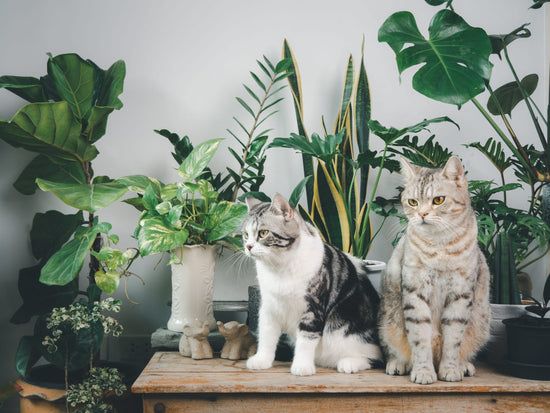Root rot is one of the most common and dangerous plant diseases that can affect both houseplants and garden plants. It is usually caused by waterlogging and causes the roots to rot. Tropical plants such as Monstera, Philodendron, Anthurium, and Alocasia are particularly affected, as they are sensitive to permanently wet roots.
Once it breaks out, root rot can quickly lead to the death of the plant. But if you recognize the signs early and act correctly, there's often still a chance to save your plant.
What is root rot?
Root rot describes the death and rotting of a plant's roots . This occurs when the roots are exposed to excessively moist soil for an extended period of time and begin to rot.
Rot is often caused by fungi and bacteria that multiply rapidly in humid environments. Once the roots are damaged, they can no longer absorb nutrients and water, severely weakening the plant.
Which plants are particularly susceptible?
Tropical houseplants are particularly susceptible to root rot, including:
- Philodendron
- Monstera
- Anthurium
- Alocasia
- Syngonium
- Calathea
- Orchids
Herbs such as basil and mint or vegetables such as tomatoes can also be affected.
Causes of root rot
The most common cause of root rot is waterlogging , i.e., excess water that doesn't drain properly. But there are other factors that increase the risk:
Excessive watering
- If plants are watered too frequently or too much, the substrate remains permanently moist.
- Especially in winter, when plants use less water, incorrect watering can quickly lead to rot.
Poor drainage
- Wrong substrate : Normal potting soil often retains too much water, while permeable mixtures with perlite, pine bark and coconut fibers prevent waterlogging.
- No or too few drainage holes : In pots without drainage, water collects at the bottom, which softens the roots and promotes rot.
Fungal and bacterial infections
- Pathogens such as Pythium, Phytophthora and Rhizoctonia thrive in moist, poorly aerated soils and attack weakened roots.
Cold temperatures & humidity
- At low temperatures, the plant grows more slowly and requires less water – excess moisture cannot evaporate quickly enough.
- Very high humidity in combination with wet substrate further promotes rot.
Symptoms and detection of root rot
Root rot begins in secret, as the initial damage occurs in the roots. But there are clear signs that indicate a problem:
Visible signs on the plant:
- Yellow or wilted leaves : The plant appears sick and shows growth problems.
- Brown, mushy roots : Healthy roots are firm and white or light brown.
- Musty smell from the pot : A foul smell is a sure sign of rot.
- Weak growth : The plant does not produce new leaves or lets existing leaves droop.
- Fungal or mold infestation : White or black spots on the soil surface may indicate fungal infestation.
The root test
To be sure that it is root rot, you should carefully remove the plant from the pot:
- Remove the soil and examine the roots.
- Healthy roots are firm, bright and elastic.
- Rotten roots are dark brown to black, mushy and break easily.
Treatment of root rot
If the plant is already affected, there are several ways to save it. The sooner you act, the higher the chances of survival.
First aid measures
-
Remove plant from pot
- Carefully remove soil.
-
Cut off affected roots
- Remove all muddy roots using disinfected scissors or a sharp knife.
-
Disinfect root remains
- Treatment with cinnamon, activated charcoal or a fungicide can help kill bacteria and fungi.
-
Fresh substrate and a clean pot
- Plant in fresh, well-drained soil and prevent waterlogging.
-
Watering correctly
- After repotting, do not water for a few days to allow the roots to recover.
Home remedies for root rot
- Cinnamon : Natural antiseptic against fungi.
- Activated charcoal : Helps bind excess moisture and reduce bacteria.
- Chamomile tea : Can be used as a mild disinfectant for the roots.
Prevention of root rot
To prevent your plants from developing root rot, you should follow a few basic care tips:
-
Use drainage holes in the pot
- So that excess water can drain away.
-
Choose a loose, permeable substrate
- A mixture of potting soil, perlite, pine bark and coconut fiber prevents waterlogging.
-
Adjust watering behavior
- Only water when the top 2-3 cm of soil is dry.
-
Improve air circulation
- Good ventilation prevents fungal and bacterial growth.
-
Avoid cool temperatures
- At temperatures below 15 °C, the plant's water consumption is reduced.
Root rot is a serious plant disease that is primarily caused by improper watering and poor drainage. Early signs such as yellow leaves or weak growth should be taken seriously.
Once an infestation is detected, action must be taken quickly: Remove affected roots, repot the plant, and adjust watering. With proper prevention, root rot can be avoided and your plants will remain healthy in the long term.





